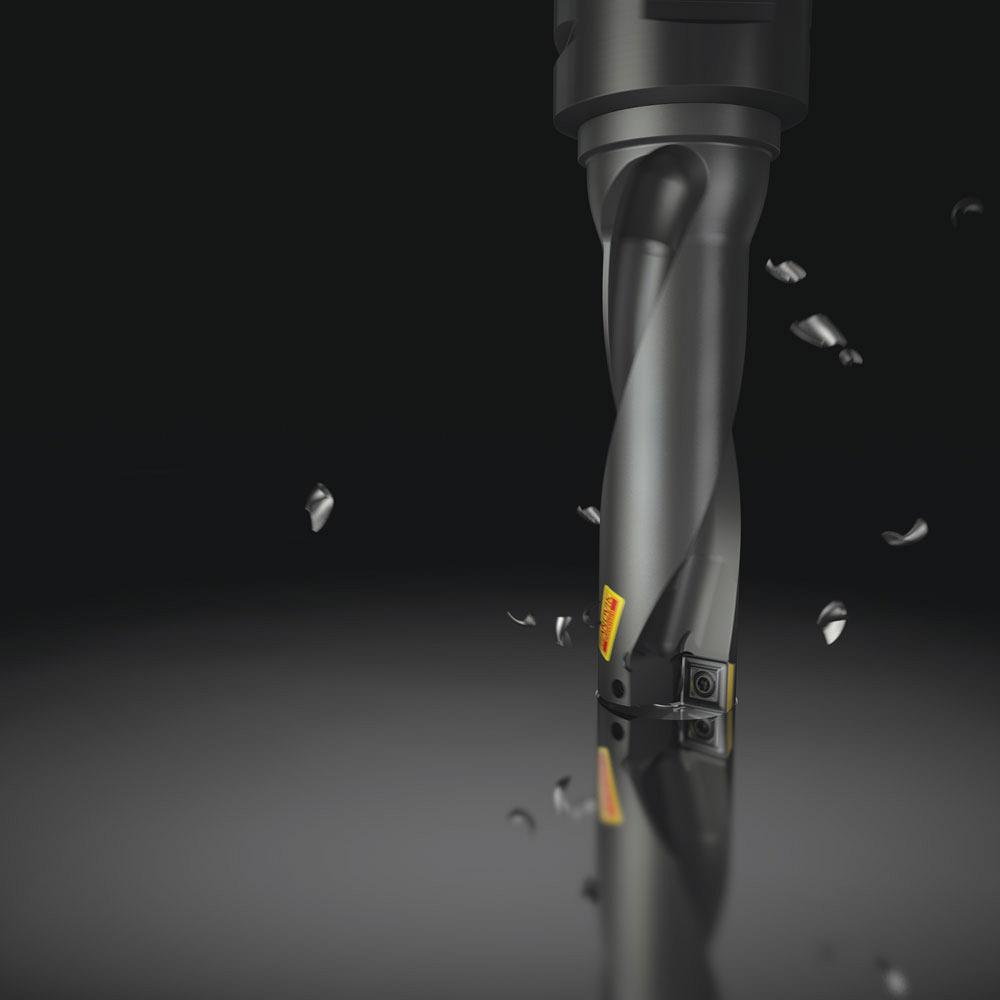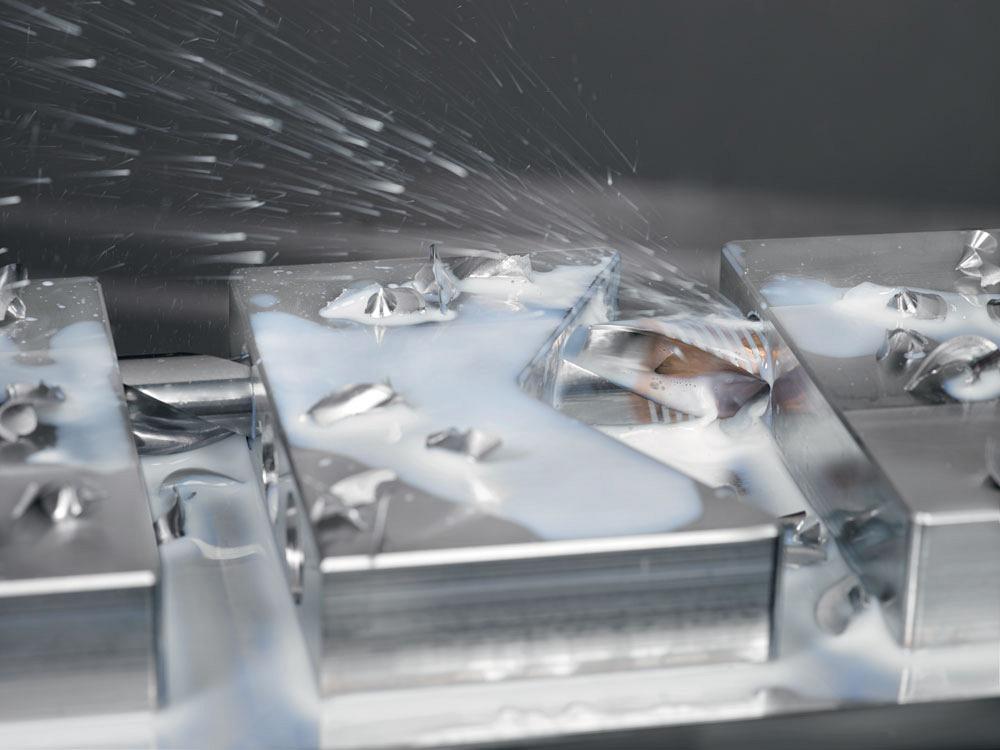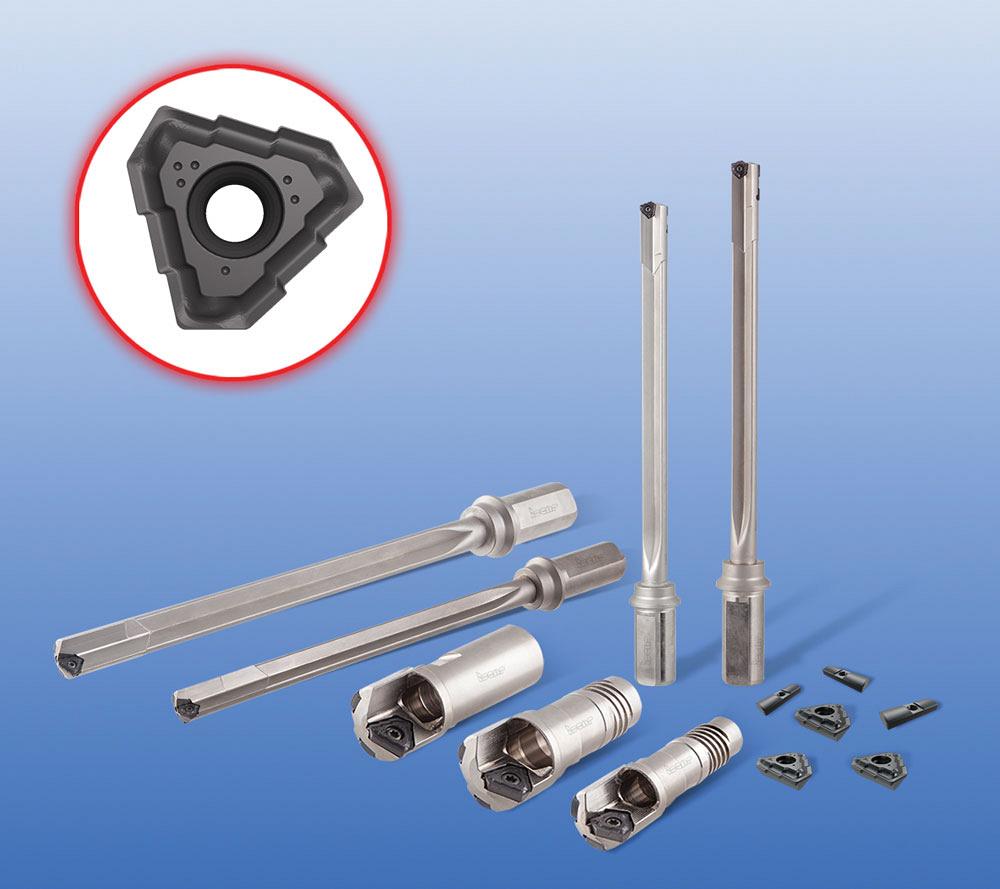- FMA
- The Fabricator
- FABTECH
- Canadian Metalworking
Control Cranky Cross Holes
Push back with cutting data, coolant, and the right tool
- By Sue Roberts
- January 11, 2016
- Article
- Management

Choosing the proper drill geometry and grade with a rigid body design helps prevent deflection when drilling cross holes. CoroDrill 880® from Sandvik Coromant is available in a many diameters. Photo courtesy of Sandvik Coromant Canada.
Drilling cross holes can make an operator, well, cross. A drill likes to be supported by the hole it has made. When it’s not, there can be problems. Yet, cooling channels are still needed in dies, molds, and components for many applications that require intersecting internal features.
A variety of problems can occur for the part itself and the tooling. Randy McEachern, product and application specialist, holemaking and tooling systems, at Sandvik Coromant Canada, said, “Interruptions to the cut have the potential to be harmful to the cutting edges. Vibrations are always introduced to the process when crossing holes. They have a direct effect on the drill’s cutting edges, margins, or both.”
Chip evacuation can be a problem. Chips can jam between the side of the hole and the margin of the drill, marring the hole surface and the tip or edge of the tool. Or chips can be pushed in front of the drill where they are recut, damaging and even leading to catastrophic tool failure.
Burrs can occur at the hole crossing, and vibration-caused deflection can make achieving a quality hole difficult.
The curved walls of the internal hole can be a problem. “If the drill point is not engaging a flat surface, you can get some push on the drill. When the drill is going through the interruption, the drill point can start to walk so the true position is out,” said Luke Pollock, product manager for round tools at Walter USA.
Add the high speeds of today’s machines to performing a process that can’t be visually monitored and scrap can be created quickly.
David Vetrecin, holemaking product manager at Iscar Tools, said, “Unlike a milling or turning operation, you can’t see what is happening. You could be drilling 13 or 14 in. inside a part and you really don’t know what’s happening until the chips come out. And with new technology, we are drilling faster, so when something goes wrong, it goes wrong quickly.”
Recommendations for drilling cross holes vary a bit depending on the type of tooling and the manufacturer, but there is consensus in several areas:
- Slow down.
- Blast chips out with high-pressure coolant.
- Drill the larger-diameter hole first if holes are different diameters.
- Use the shortest drill possible.
- Talk to your supplier about tooling options and specials.
Slow the Process
Regardless of the type of drill used—carbide, indexable, or exchangeable head--slowing the feed is typically advised. A 25 to 75 percent reduction may be recommended as the tooling crosses the hole. Begin drilling at full feed, reduce as you approach, enter, and exit the cross hole, then return to full feed.
CAM programmers will need to take into account special considerations to allow for variations in the program for crossing holes. However, when only one hole is needed, the drilling process can be treated as an individual job, with the operator controlling feeds with manual overrides on the machine control. Some tooling manufacturers suggest also slowing the cutting speed. Some recommend slowing down during retraction.

High-pressure coolant needs to flow to the tip of the drill to flush away chips and prevent tool damage during cross-hole drilling. A Titex DC170 drill from Walter is pictured as it forms cross holes. Photo courtesy of Walter USA.
“Getting into a cross hole is like drilling through a part, but cutting data needs to be adjusted because of the curved surfaces. Adjustments depend largely on the hole quality you need,” said Pollock. “You might be punching through just because you need the space, or you might need a precision hole. As the hole quality requirements increase, the more adjustment or fine-tuning will be needed.
“As a general rule of thumb I recommend dropping speeds and feeds 50 percent, but it does depend on the situation. If you are going perfectly on the centerline of a cross hole, entering a relatively flat surface, you drop a little less. If you are entering a curved surface and the two holes are offset, the increased curvature could be a problem and you might have to slow down even more.”
Vetrecin said, “Drilling at a 45- or 30-degree angle can be more of a problem than a 90 degree. If you get in at 30 degrees, you have a longer section of the drill trying to break out without much support behind it, so you have to lengthen the support for the drill. And slow down feeds and speeds. If you are drilling with a gundrill pull out at a slower RPM so you don’t have any whipping.”
There are cases when slowing is not appropriate. McEachern said, “Stainless steels and heat-resistant superalloys have a tendency to work harden if the tool is feeding too slow and allowed to rub, so you may need a work-around.”
Blast the Chips
Good coolant flow is essential to flush chips away through the cross hole or the flutes of the drill. In deep-hole drills, the coolant flows needs to flow through the drill to the cutting edge at the correct pressure and volume. On machines that don’t have the desired pressure or volume, further adjustments to cutting data may be needed.
Vetrecin said, “When you cross the hole, the coolant isn’t being directed down the drilled hole to evacuate the chips. Some customers will stop the process to plug the holes in the plate to force the coolant back out the hole being drilled. They try to restrict where the coolant can go.”
“If you have a large drill going through a small cross hole, chips are usually not an issue. If a smaller hole is drilled through a larger one, the larger hole acts as a void. Chips that would normally follow along the drill’s flutes are going to fall off the drill and into the void,” said Pollock. “It is often possible to redirect the coolant flush lines to clean them out.”
Bottom line, said McEachern, being sure there is plenty of high-pressure coolant flowing during a cross-hole process will prevent drill damage and help create quality holes.
Drill Large Holes First With Short Drill
When dealing with different hole diameters, cut the large hole first whenever possible. A small drill crossing a larger hole has an easier breakout and entry because it is not trying to cut the entire hole at one time, said Vetrecin. Drill point stress is reduced.
“Curvature will be bigger crossing a larger diameter and that allows the point of the drill to engage on the far side,” said McEachern. “We want the point of the drill to make contact first, not the corners.”

Iscar’s TRIDEEP gundrill with deep drilling heads can use solid carbide or brazed guide pads that would assist in reducing vibration in cross-hole drilling. Photo courtesy of Iscar.
Cross-hole problems usually show up when drilling five, eight, or more times diameter because the drills have the ability to bend, said Pollock. Shorter drills, he added, are typically sturdy enough to pass through interruptions with little difficulty.
That said, choose the shortest drill possible to do the job because it will have the most rigidity and least vibration.
Investigate Options and Specials
The material being cut, hole specifications, and end product performance expectations will determine the type of drill to be used and whether considering a special is appropriate. For example, extended guide pads may be added to a gundrill to further reduce vibration, or a harder grade of carbide or tougher coating may be chosen to protect the tool.
“In some cases, special tools are manufactured,” said McEachern. “Carbide pads can be used on indexable drills for deeper applications, or a specific geometry on some gundrills offers more circumferential contact combined with longer pads to add stability when crossing or counterboring holes.”
Vetrecin said, “In deep-hole drilling you can use a drill with a cross-hole adapter, a guide mechanism behind the cutting edge that remains a good distance back from the through-hole during cutting, to support the drill as it enters the far side of the hole. That will help reduce chatter, deflection, and chipping on the cutting edges.”
“When we talk about specials,” said Pollock, “we look at the application and ask what we can do with a special design to alleviate too much deflection—different geometries, different coatings. With a custom tool design everything is on the table.”
subscribe now


Keep up to date with the latest news, events, and technology for all things metal from our pair of monthly magazines written specifically for Canadian manufacturers!
Start Your Free Subscription- Trending Articles
- Industry Events
MME Winnipeg
- April 30, 2024
- Winnipeg, ON Canada
CTMA Economic Uncertainty: Helping You Navigate Windsor Seminar
- April 30, 2024
- Windsor, ON Canada
CTMA Economic Uncertainty: Helping You Navigate Kitchener Seminar
- May 2, 2024
- Kitchener, ON Canada
Automate 2024
- May 6 - 9, 2024
- Chicago, IL
ANCA Open House
- May 7 - 8, 2024
- Wixom, MI














